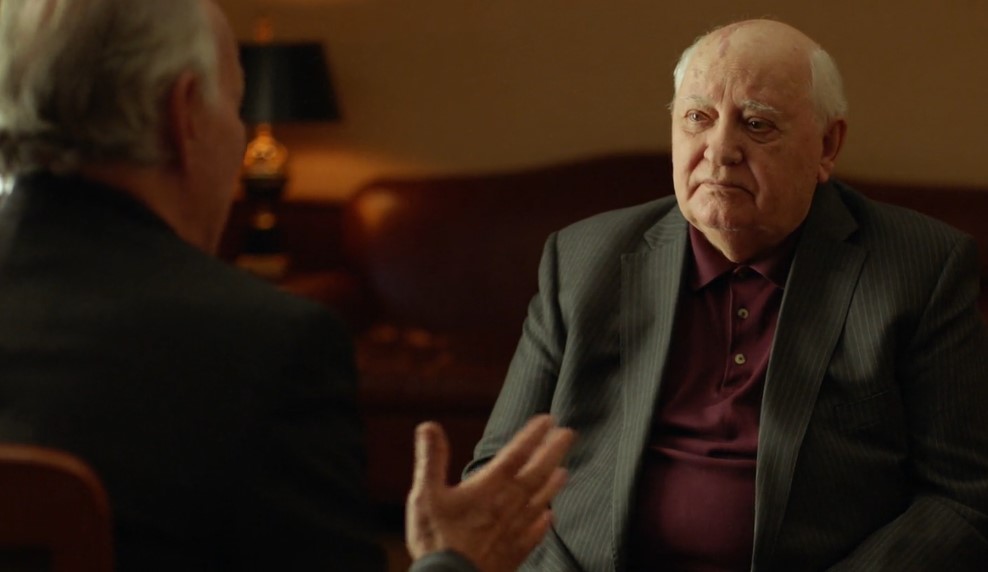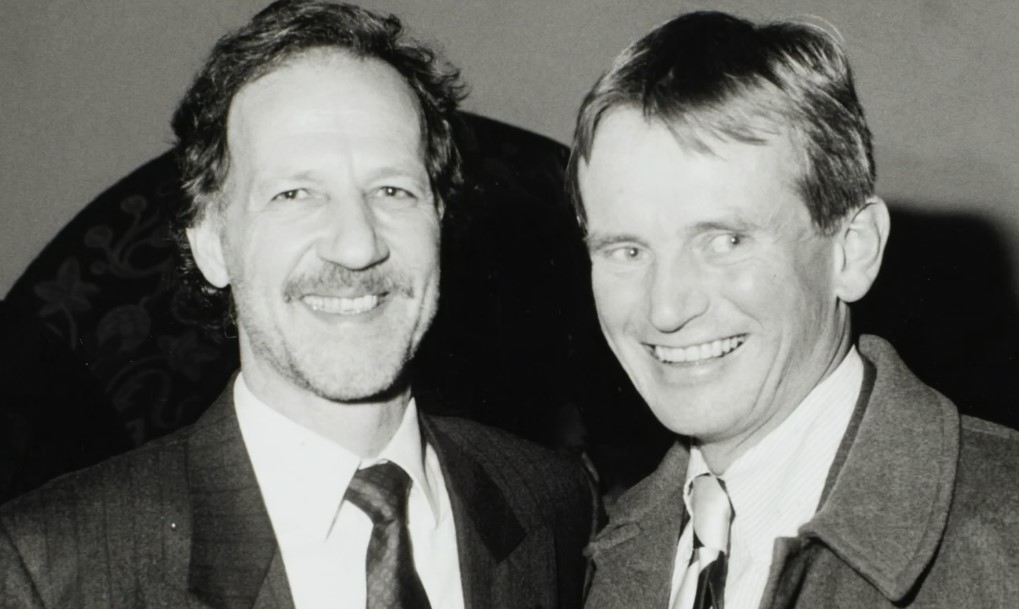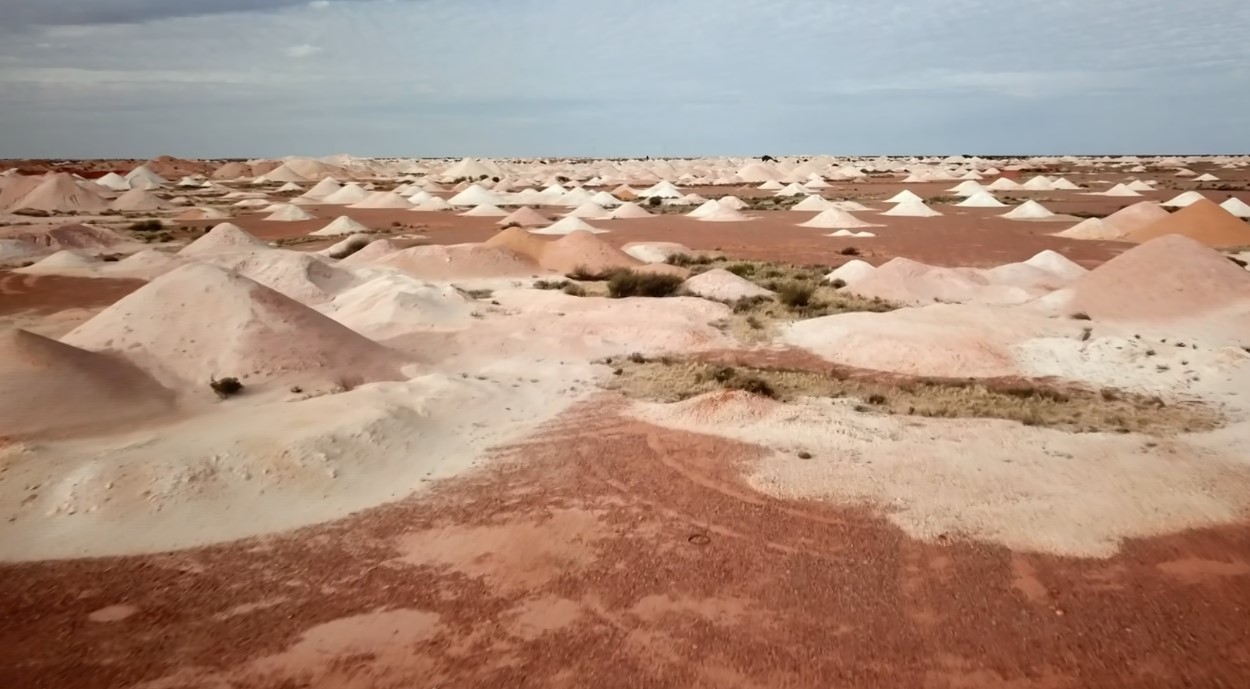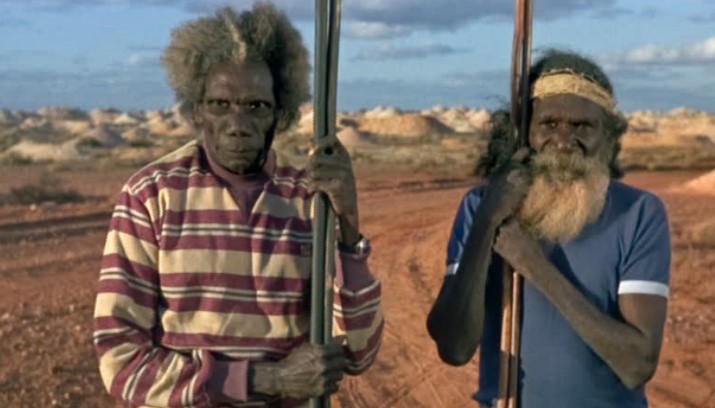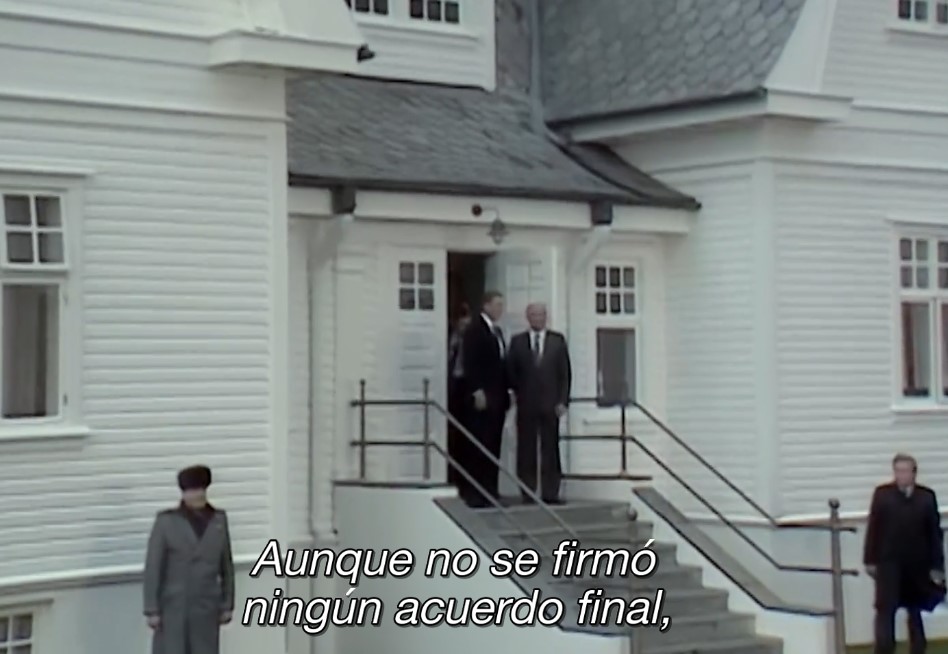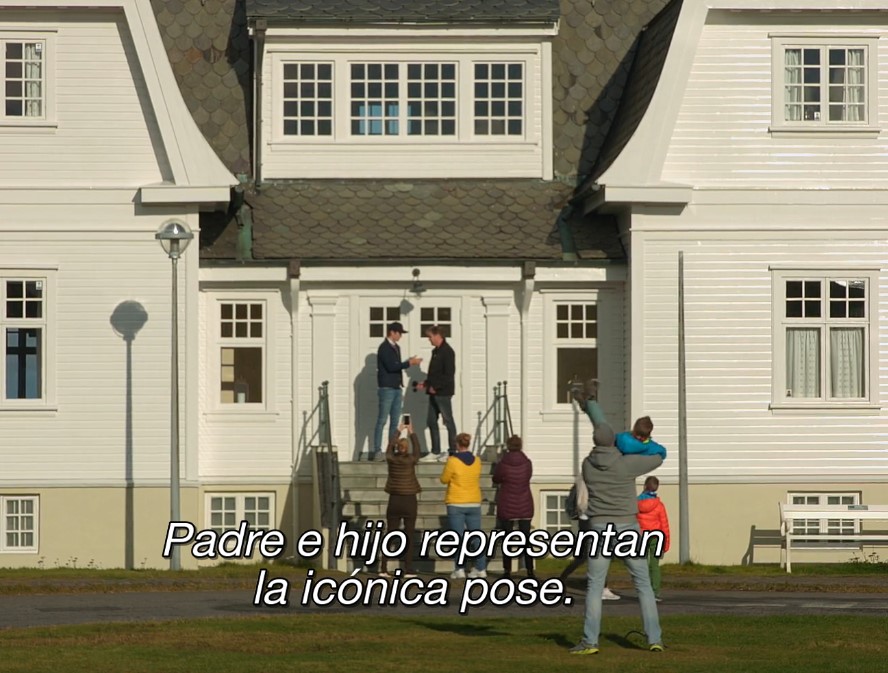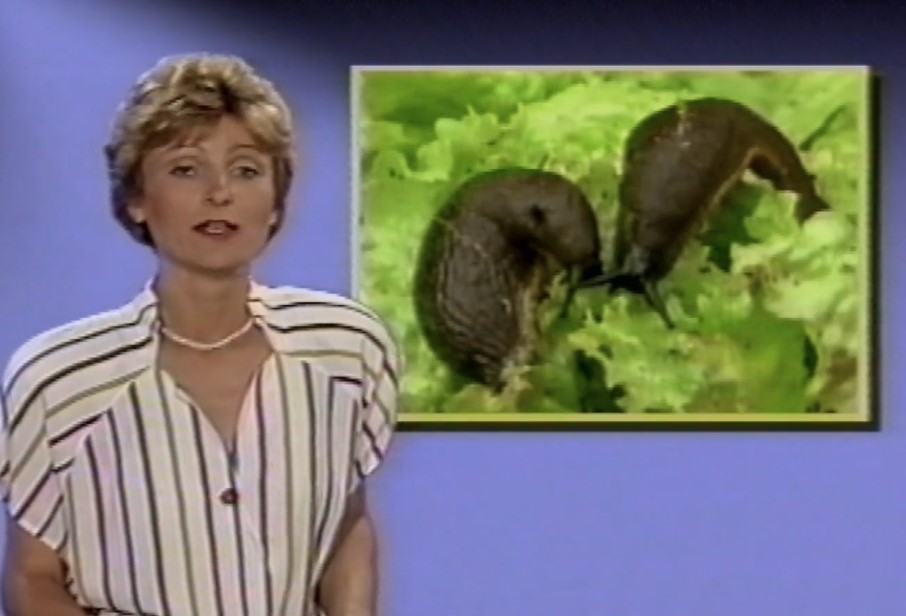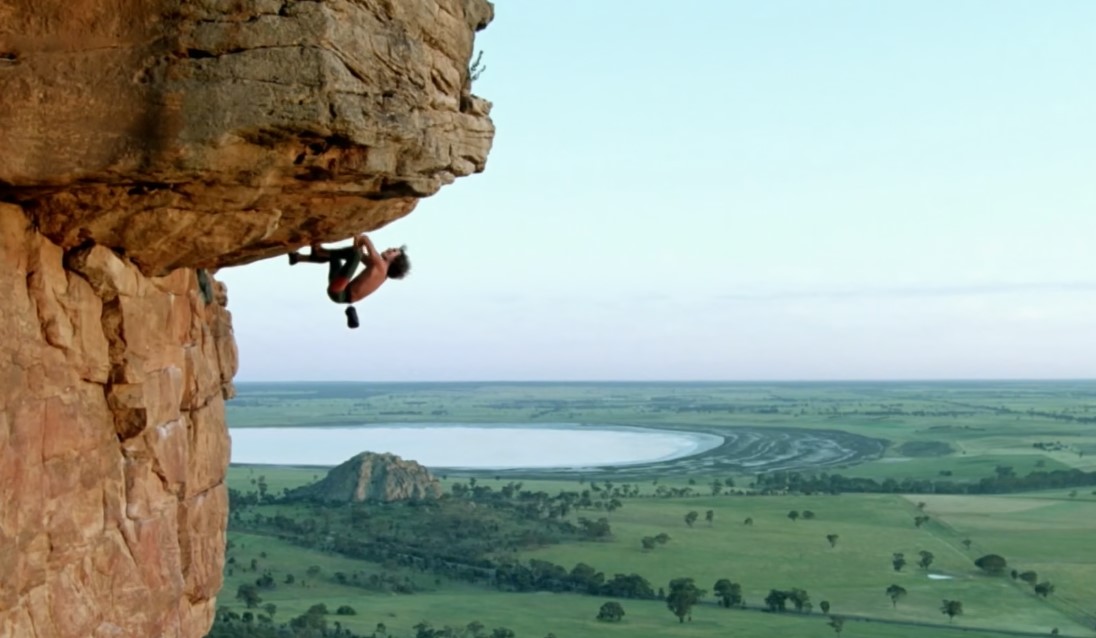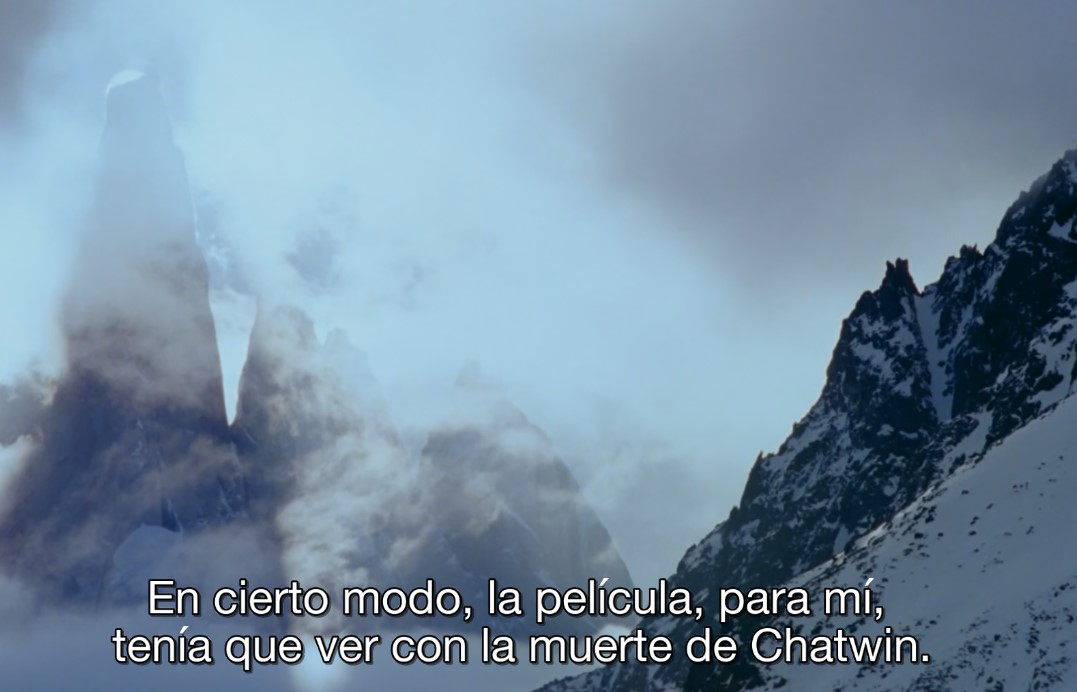Biographies in the Cinematic Realism Of Werner Herzog. Discourse for Remembering and Thinking about the Present
- Fabiola Alcala Anguiano
- ― see biodata
Biographies in the Cinematic Realism Of Werner Herzog. Discourse for Remembering and Thinking about the Present
Receipt: June 30, 2023
Acceptance: November 22, 2023
Abstract
The cinema of the real is nourished by reality in order to reflect on it. It differs from traditional documentary because it has no pretensions to objectivity. Werner Herzog has made more than fifty films of the real; among them is a series of portraits of extraordinary characters. In this text we will analyze two of them: Meeting Gorbachev and Nomad: In the Footsteps of Bruce Chatwin. Both films aim to tell a biographical story that has implications for the present. Thus, through this analysis, it is proposed to reflect on the ways of remembering, on the interview and on the performance as techniques of the cinema of the real. The analysis is divided into the parts of rhetorical discourse: arguments, order and rhetorical figures, to see how the version of these stories that tell biographical data, but also reflect on current events, is constructed.
Keywords: Biography, cinema of the real, interview, memory, performance, Werner Herzog
biographies in the cinematic realism of werner herzog. discourse for remembering and thinking about the present.
Cinematic realism is fed by reality to reflect on it. It is distinguished from traditional documentaries because it does not claim to be objective. Werner Herzog has made more than 50 realism films, and among them are found a series of portraits of extraordinary characters. This text examines two of these: Meeting Gorbachev and Nomad: In the Footsteps of Bruce Chatwin. Both films seek to tell a biographical story that has implications for the present. This study sets out to reflect on the ways of remembering, on the interview, and on performance in cinematic realism. The study is divided into parts of rhetoric -arguments, arrangement, and figures of speech- to see how these stories are shaped by the German filmmaker.
Keywords: cinematic realism, biography, memory, performance, interview, Werner Herzog.
Introduction: the cinema of the real
The cinema of the real is that which is concerned with the problem of what happens in the world and in life, not only to try to represent it, but to understand its complexity. As Josep María Catalá states, it is "a type of cinema that seeks its materials in reality, rather than in fiction, that uses what already exists instead of constructing it for the camera" (2010: 48). The cinema of the real includes the subjective documentary, the film-essay, the mockumentary, etc. In other words, all those reflexive and authorial forms that go beyond the pretensions of objectivity of the traditional documentary.
This type of cinema explains its stories from the first person. The voice, the gaze and the interaction of the filmmaker are essential parts of it and make evident the performative exercise, which implies that everything we see on the screen -despite coming from reality- is a mise-en-scène, as Stella Bruzzi points out:
At the same time, I felt that documentary theory had not kept up with critical theory. With what was happening beyond cinema. Documentary practice was not relating, for example, to the work of Judith Butler, or was beginning to do so but only at the level of content and not form. This was important because I argued in my book that every documentary is a performancein the sense that what you see on the screen is fundamentally different from what you would see if the camera wasn't there. It's always going to be different. However, it's not necessarily false, untrue, and it doesn't mean you shouldn't believe it. What it is, is an acknowledgement that the camera is there. If I put a camera here, you will not become a completely different person, but you will react to it, acknowledging its presence. So what I was arguing is that what we should be analyzing is what is happening on the screen. Not to say that it does not represent reality and therefore failed, but to create something different, that we should not destroy (Bruzzi in Pinto Veas, 2013: 2).
The cinema of the real is, therefore, a cinema that assumes its performative character and with it the implication of the author. In every film of the real there is a point of view that conditions and transforms what is presented: the real is subordinated to this particular way of seeing the world and is exposed with this filter without trying to hide it. The filmmaker is part of the film and does so without dissimulation, making clear his position, his ideology and his participation in the mise-en-scène. These characteristics are clearly in opposition to the traditional documentary which, on the contrary, carries pretensions of objectivity and neutrality.
One of the filmmakers who has made a large number of subjective, essayistic and even mockumentary pieces is Werner Herzog, so his work can and should be understood as cinema of the real (Alcalá, 2013). This means that his documentary films make use of real materials that are reappropriated and transformed to create a different meaning, always from his perspective, and in this way he builds a filmography with its own characteristics in which the filmmaker is just another character in the stories he tells. The German filmmaker, to refer to his films, often uses the phrase "I am my films", placing the emphasis on the subject who films and not on what is filmed.
In his recent productions we find life stories or biographical films that start from the individual story, but that help to think about more universal themes that go beyond the specific case.. In this text we will analyze two of them: Meeting Gorbachev (Werner Herzog and André Singer, 2018) and. Nomad: In the Footsteps of Bruce Chatwin (Werner Herzog, 2019). In these films the mise-en-scène or performance allows to create a reflection on the past, the present and their tensions, by highlighting the functioning of the mechanisms for remembering and their uses in the cinema of the real as part of a discourse in which the filmmaker and the present are also involved. Two films from a very extensive filmography, which has become more sophisticated over time and has created a very particular style of approaching reality.
Memory, interview and staging
Life stories in cinema tend to be pieces that reorganize the past and give it a new meaning in the present. The interesting thing about this time travel is that, in addition to explaining events that have already happened, they make visible the question of how we remember. Memory is the vehicle for remembering, it becomes the protagonist of this apparently orderly exercise of recovering experiences, but an important characteristic that must be recognized about it is precisely its selective character. In the words of Tzvetan Todorov:
First of all, we must remember something obvious: that memory is in no way opposed to forgetting. The two terms to be contrasted are deletion (forgetfulness) and conservationMemory is, at all times and necessarily, an interaction of both. The integral reestablishment of the past is of course impossible (but Borges imagined it in his history of the past). Funes, the memory lover) and, on the other hand, frightening; memory, as such, is necessarily a selection: some features of the event will be preserved, others immediately or progressively marginalized, and then forgotten. This is why it is deeply disconcerting when one hears computers' ability to retain information called "memory": the latter operation lacks a constitutive feature of memory, i.e., selection (2000: 15-16).
The cinema of the real shows this selection process mainly through testimonies that explain what happened. In these statements in front of the camera, the selection involves even more elements, since not only is what happened remembered in a fragmentary way, but it is recovered for the creation of a film. It is an exercise in rewriting what happened, but designed to be shown on the screen.
This operation is similar to cinema itself, as Javier Acevedo and María Marcos point out:
Our own memory functions similarly to the cinematograph: we select a few fragments or realities from a myriad of possibilities, we choose to perceive and remember those moments that can construct a personal narrative that molds to our knowledge, and we automatically believe that this way of seeing reality reflects the pure movement, the inner becoming of all things (2018: 42-43).
Within this framework, a story-memory is created for the camera that can function to evoke, to reorder, to revive, and sometimes even to liberate:
The past thus becomes a principle of action for the present. In this case, the associations that come to my mind depend on similarity and not on contiguity, and rather than assuring my own identity, I try to find an explanation for my analogies. It could be said then, in a first approximation, that literal memory, especially if it is taken to the extreme, carries risks, while exemplary memory is potentially liberating (Todorov, 2000: 31).
This selection process can become a healing process. The cinema of the real has often experienced it, especially when it comes to remembering painful events -an emblematic example can be Shoahthe film by Claude Lanzmann in which he interviews Holocaust survivors (Sanchéz Biosca, 2001). In the face of trauma, exemplary memory allows for liberation, while literal memory can relive events that, if violent, may be more distressing than liberating and, possibly, become a new trauma. Hence, this type of cinema has often had to ask itself how it intervenes in a process of remembrance and what ethical limits it should impose on itself when approaching the past.
The in-depth interview, which is an exchange that requires intimacy and extracts information from the interviewee's biography (Marradi, Archenti and Piovani, 2007), is usually the most widely used tool when constructing life stories, since the weight of first-person recollection adds an ingredient of veracity and emotion to the story. It is about giving voice to those who lived the event. This resource in the cinema of the real, in addition to being a mechanism to obtain statements (whether traumatic or liberating), is a device -in terms of staging- that allows us to recognize how the interview took place. The exercise of interviewing is itself a reflexive enterprise, as Kathy Davis explains:
The interview has come to be seen more as a co-production, something constructed together with the collaboration of participants who have their own, sometimes opposing, set of interests and their strategy for dealing with them during the interview. This shift in understanding the interview as a reflexive enterprise stoked among biographical researchers an interest in what happened during interviews: the ruptures in the interaction, the misinterpretations and problems, as well as the attempts to repair those ruptures, the ongoing attempt at seduction, and the unexpected turns a conversation can take (2003: 156).
In the cinema of the real, the staging of the interview involves both the interviewees and the interviewer, and the interviewer's personal story is just as relevant as the story he or she is trying to order and present:
The personal, social or intellectual biography of the researcher is no longer considered irrelevant in telling the story of the interviewee (as it was under the "sociologist as footnote approach", or in the tradition of "realist" research). On the contrary, the researcher's biography has proven to be a useful tool not only in explaining the analytical processes involved in understanding what is going on in the life of the other, but more generally in understanding how sociological knowledge is produced (Davis, 2003: 157-158).
Therefore, within this study we intend to recognize the selective character of memory, particularly the choice of memories that is made for the camera, as well as the condition of risk that opposes the liberating condition of the act of remembering. Likewise, we seek to place these concepts within the framework of the interview, since in addition to its function as a tool to obtain information, which involves the personal history of both the interviewer and the interviewee, in the cinema of the real it can be understood as a mechanism that makes evident the negotiations and agreements between the parties by revealing the existing agreement to create the performance or, in other words, the film.
The looks, the silences, the place where the interview takes place, the arrangement of the characters, all contribute to a mise-en-scène that follows aesthetic and cinematographic guidelines, but also provides clues to distinguish under what conditions the memory is remembered, how the atmosphere of the filmed memory is constructed and what implications it may have to remember this or that event from the present and with the conditions already mentioned.
Speech and persuasion
The cinema of the real, unlike the cinema of fiction, is constructed as a discourse and not as a story. Discourse confers reasoning and/or reflection, while narrative does not necessarily do so, since the latter is devoted to describing, to narrating. This dissimilarity conditions the starting point for the models of analysis of films of the real, which must take into account this primary condition and, perhaps, renounce narrative analysis in favor of approaching their object by assuming that every film of the real is a rhetorical discourse.
In this sense, this text recovers the model of analysis proposed by Arantxa Capdevila in El discurso persuasivo. La estructura retórica de los spots electoral (2004). The author proposes an audiovisual rhetorical analysis in order to study spots Although they are not films of the real, they maintain the same starting point: persuasion.
In this model, audiovisual discourse is divided in the same way as rhetorical discourse by recognizing a central argument and several subarguments (inventio), an order that conditions persuasion (dispositio), a way to embellish the arguments (elocutio) and a presentation to the public (memory, actio) -in this case, the exhibition of the film-. Each of these parts exposes how the strategy of persuasion is constructed, which in the advertisement The purpose of an electoral campaign is to convince the audience to vote for this or that political party (Capdevila, 2004). However, in the cinema of the real, this persuasion consists of convincing the viewer to think or even feel something in particular.
In the case of the biography, on which the pieces to be analyzed are based, persuasion is related to history, since the film presents a series of testimonies that, by way of remembrances, help to organize a version of the past. The purpose of the biographical film is to have a portrait of how the life of this or that character was, but in this rewriting exercise, ideologies, points of view, relations with the present, etc., can be revealed. To think history is to think the present, as Jacques Le Goff (1991) affirms, and the way in which the discourse is told and constructed indicates that there are different possible versions of memory. For this reason, if we talk about the selected films, the story of Mikhail Gorbachev or Bruce Chatwin would not be the same if they were told by a filmmaker other than Werner Herzog.
Werner Herzog's Cinema of the Real
Werner Stipetic, better known as Werner Herzog, changed his last name because Herzog means "duke" and he intended to be the duke of cinema as Duke Ellington was in music. Born in Bavaria in 1942, it is said that he grew up away from the media, even making his first phone call at the age of 17. There is a rumor that he entered film school, but did not finish his degree. However, he stole a film camera leaving a note: "This is a creative loan", since, as he claims, filmmaking is done on foot and is not learned in school. His great journeys on foot and his eagerness to film in the most inhospitable corners of the globe are well known (Prager, 2007).
He was part of the New German Cinema, signing the Oberhausen manifesto alongside filmmakers such as Rainer Werner Fassbinder, Wilhelm Ernst Wenders and Alexander Kluge. For them, German cinema had to change: "Kill the old cinema and create a new one" was the mission of this group that had the need to rewrite the history of a Germany disrupted by the war. Each one of them, with a very particular style and with different concerns, but with the aim of reviving German cinema, which had been one of the most innovative and powerful in world cinema (Alcalá, 2010).
Werner Herzog began his filmography by making cinema of the real from his first short film called Heracles (HeraklesWerner Herzog, 1962), in which he contrasted images of bodybuilders with texts from the myth of Hercules, accompanied by the music of jazz. Images of the real reorganized to propose that contemporary heroes no longer possess the qualities of classical heroes. Since then to date he has made several films with characteristics of the cinema of the real: essays such as Fata Morgana (Werner Herzog, 1971), fake documentaries such as The Wild Blue Yonder (Werner Herzog, 2005), and a long list of biographical portraits such as Little Dieter Needs to Fly (Werner Herzog, 1997), and like the two studied in this research.1
In the field of biography, the selection of his characters is very similar to that of his fictions: either he approaches stories of crazy and mad heroes like Aguirre and Fitzcarraldo; or authentic, pure and romantic characters like Kaspar Hauser. The characteristics of the first group can be seen in Timothy Treadwell, the activist who tried to take care of the bears in a protected reserve in Alaska and who was the protagonist of Grizzly Man (Werner Herzog, 2005). As well as Gene Scott, the pastor who had a television program in which he insulted his faithful for not donating enough money to the church in God's Angry Man (Glaube und WährungWerner Herzog, 1981). As an example of the second group we find Fini Straubinger, a blind and deaf woman who teaches others how to communicate through their hands in Land of Silence and Darkness (Land of the Swiss and the DunkelheitWerner Herzog, 1971). And Walter Steiner, the carpenter who was also a ski jumping champion in The Great Ecstasy of Woodcarver Steiner (The great phase of Steiner's bildschnitzersWerner Herzog, 1974).
There is something extraordinary about all of these characters. Some are daring, intrepid, fanatical, unique. They seem like mythological beings drawn from classic novels rather than from islands, deserts, poles, caves and cities; places all over the globe where the German filmmaker has set his camera and made it clear that he, like the characters in his films, possesses many of these characteristics. In the words of Thomas Elsaesser: "Herzog's heroes do not merely exclude the world of the commonplace, the space where most human beings organize their lives, but exist in a vacuum due to a determination to investigate the limits of what it means to be human to any extent" (1989: 220).2
In this context, the films analyzed in this project raise the following questions: what is Mikhail Gorbachev like as presented by Herzog; from the same perspective, what is Bruce Chatwin like; what themes lie behind these biographical exercises for the camera; what is the relationship between these portraits and the rest of his filmography; and what is the relationship between these portraits and the rest of his filmography?
Analysis of Meeting Gorbachev and Nomad: In the Footsteps of Bruce Chatwin
The analysis has been divided into the essential parts of rhetorical discourse. Each of them will be explained by considering the elements of the memory and the performance that condition them. The exhibition will be comparative between the two films because elements in common are recognized, as well as contrasts that enrich the study.
Inventiothe arguments
Meeting Gorbachev is a film that explains what role Mikhail Gorbachev played in Russian politics and what implications his rule had on international politics and his own history. While Nomad: In the Footsteps of Bruce Chatwin describes who this explorer was as he travels through the places he visited and which were depicted and detailed in his books.
The central arguments allow us to think of two pieces that will dedicate their time to remember the two characters in a traditional way. In the first case with the protagonist as a witness, which implies that he is the one who reflects years later on his personal and political career, on his achievements and on his duels. The central resource is the interview, the interviewer and the interviewee together organize the biography.
In the second case, it will be the others (those who knew the character) who will help to think about who Chatwin was, including Herzog himself. It is a film as a tribute because the character of the story is no longer there, only his texts and the testimonies of those who were close to him remain to explain him.
They seem like ordinary biographies that meet the requirements of evoking memories through testimonies and/or archival images that illustrate scenes from the past. However, Herzog's role has an interesting prominence in both films, as he makes it clear that he selects, adjectivizes, judges and even jokes with what he shows. He makes it visible that he admires both characters, criticizes their opponents and presents them as misunderstood heroes - as controversial as his opinion can be. This gesture conditions what is remembered, since the filmmaker's point of view is the predominant one in the story.
The selection of the memories that are exposed is made by the interviewer and often says more about the interviewer than about the characters he or she is interviewing. This guide also reveals the non-linear condition of memory, as Elizabeth Jelin states: "There are contradictions, tensions, silences, conflicts, gaps and disjunctions, as well as places of encounter and even of 'integration'. Social reality is complex, contradictory, full of tensions and conflicts. Memory is no exception" (2002: 17). The interview helps to put these characteristics in camera and this is how the arguments are presented.
Dispositiothe order
Meeting Gorbachev is organized by themes: first it explains the childhood of the former Soviet leader, then how he entered the Communist Party and Russian politics, what he did as a leader, how he created perestroika, how he developed his policy to get rid of nuclear weapons and how he lived through events such as the Chernobyl tragedy, the fall of the iron curtain and the coup d'état that would be the end of the Soviet Union. In the last moments of the film he also talks about his wife, the illness he suffered and his death.
For its part, Nomad: In the Footsteps of Bruce Chatwin is organized by chapters. It is a poetic rather than biographical piece and this can be seen by the way the chapters are named: "In the Skin of the Brontosaurus", "Landscapes of the Soul", "Songs of the Earth", "Nomadic Alternative", "Journey to the End of the World", "Chatwin's Backpack", "Green Cobra" and "The Book is Closed". 3
The order of Meeting Gorbachev seems to follow that of any biographical-chronological document, since the scenes -constructed with archival images, interviews with other leaders and politicians, as well as with Gorbachev's own interview- help to explain each stage of the Soviet leader's life. However, the end of the film is interesting and different, in which Herzog proposes a double reading of mourning: on the one hand, the disintegration of the Soviet Union and, on the other, the death of Raísa, Gorbachev's wife.
The mourning for the loss of his wife shows a wounded, sad, desolate character. The scenes of grief will serve to remember Raísa, but they are also useful as a mirror of the enormous sorrow of having seen the destruction before his eyes of the political and social project for which he had fought so hard. The memory of both losses is extremely painful. When Herzog asks him what the end of the Soviet Union meant to him, Gorbachev replies "it still hurts" and sinks into a saddened silence. The camera keeps rolling and his expression says much more than any answer.
In Nomad: In the Footsteps of Bruce ChatwinThe chapters break with the chronological idea and propose a fragmentary reading of a life in the service of walking, exploring and narrating. Each chapter has little to do with the previous one or strictly with the biography. Rather, it dwells on some idea, place, interest or even object shared by the explorer and the filmmaker, such as his backpack. The whole film seems to explain why Herzog found Chatwin so interesting and why his way of creating stories and crossing the world appeals so much to the German filmmaker.
As in Meeting GorbachevThe ending of the piece is perhaps the least traditional in a biography because the illness of the protagonist is discussed until the last chapters and without too much emphasis. Herzog decides to explain Chatwin because of his work rather than because he is a victim of the hiv.
The secondary arguments -those that help to understand each theme and/or each chapter- will be guided by the interviewer, since he is the one who suggests the ideas or the questions, as well as many times he also provides or directs the answers. For example, in both films the widowers (Gorbachev and Elizabeth Chandler, Chatwin's wife) are asked if they still hear them laugh, if they remember their laughter. The filmmaker puts the memory on the lips of both interviewees and this mechanism is repeated several times in the two films.
Elocuitofigures and images
Throughout these films it is possible to find a series of audiovisual figures that, as in a rhetorical discourse, function to embellish and to reinforce the sense of what is to be argued. These metaphors, ironies and comparisons reinforce the memory and its implications. In these pieces were found: mirror-imagesin which the subject matter alludes to another subject or poses a clear comparison; images-humorThe irony allows us to create a synthesis of a more complex subject and to highlight that complexity. images-landscapespaces that become metaphors of universal themes or of feelings that are proper to the characters, but that also reach a degree of nostalgia for what was and is no longer. 4 Every cinematographic image in itself carries a past and a present, every filmed image no longer exists as such, and this condition is revealed in Herzog's landscapes.
Mirror-images
In the exercise of remembering, the present, the past and their possible relationships are revealed. Thinking about the government of a political leader of the past allows us to reflect and create situations in which what is revealed is the question of the now: what are the political leaders of the present like? In the case of the explorer the situation is similar: thinking about what places he visited and what spaces inspired his books uncovers the question of what are the themes for the other explorer, the one who recovers Chatwin's life, that is, for Herzog. In this sense, in both films we find mirror-images: moments in which the past functions to think about the present, looking for reflections, echoes or resonances between them.
For example, one of the main themes of Gorbachev's government -which is recovered in the piece through testimonies, archive images and the former Russian president's own account- is his work in the destruction of the nuclear arsenal in the middle of the Cold War. This historical event, as explained in the film, generated different opinions and at the time there were those in favor and those against, but the mirror-image is created in the present statements, when it is explained that the current president of the United States declared that he will modernize his nuclear arsenal, making it clear that all that effort is about to be forgotten. It is interesting how the debates and opinions of that time are still valid, as if we were in the same place, without taking into account the passage of time.
In the case of Nomad: In the Footsteps of Bruce ChatwinThe mirror-images are produced when comparing Chatwin's work with Herzog's, as shown in figures 3 and 4. Both are interested in mythology, in forgotten tribes and their traditions, in the little explored and unknown spaces of the world. The film builds this parallelism almost from the first minute and the mirror-images are achieved by combining images from the present that aim to point out the places in which the explorer was interested with images from Herzog's films.5 This exercise composed of disordered moments and details resembles the procedure of memory which, as mentioned, is selective and fragmentary, and returns to the same places.
Images-humor
Irony is one of the most common figures in Herzogian filmography (Alcalá, 2017), through ironic humor the German filmmaker reflects on complex and serious issues that require rethinking. An example of this can be found in The Flying Doctors of East Africa (The fliegenden Ärzte von OstafrikaWerner Herzog, 1970), as it shows how the aborigines of the area did not identify the representation of the mosquitoes that cause a serious eye infection because in the plates presented to them by the doctors both the mosquitoes and the eyes were too big. Africans say they do not have that problem because there are no mosquitoes of that size in the area. The voice in off explains that the members of the tribe are not stupid, but that for them a sheet that separates one eye from the face and multiplies its size makes no sense. The scene is ironic and the figure allows us to think about something as complex as the need to understand the other before trying to help him, that is, the need to know how to communicate:
After showing us the results of his experiment, Herzog's narration concludes by reminding us that his intention was not to prove that these Africans were stupid, but that they see something different from what we see, even when we have identical images before our eyes. Herzog's narrator adds, "After centuries of colonial rule in Africa, even now we haven't reached the beginning of knowing how to communicate. If we really want to help, we must start again with this kind of communication, right from the beginning" (Prager, 2007: 173-174). 6
In the films reviewed in this research there are also several ironic scenes that have this reflexive force. In Meeting Gorbachev explains the historic meeting between Gorbachev and Ronald Reagan in Reykjavik, Iceland. That house, where nowadays tourists take pictures imitating the handshake, was the scene where the image of the truce between the two nations was created. The fact that tourists go there to imitate the scene is hilarious; but, at the same time, it is a gesture loaded with nostalgia, since it alludes to a peace that had consequences for the character and for the world.
Another scene of ironic images in Meeting Gorbachev is that of the funerals, in which it seems like fiction how the different Soviet leaders die in such a short time and how their pompous funerals are celebrated almost identically, one after the other. First Leonid Brezhnev, then Yuri Andropov and finally Konstantin Chernenko. The images are repeated, revealing the protocol: the one to whom condolences are offered will be the next leader. Thus it is shown how, after the sick Chernenko, it was to Gorbachev that the condolences were addressed and, therefore, his moment to rise to power. In the repetition and in that sense that there is someone else organizing the scene lies the irony.
One more fragment that corresponds to this type of image is from the Austrian news on the day the Hungarian borders were opened. The note about how the barbed wire on the border - a symbol of the beginning of reunification - was being cut was brief and gave way to a much longer report about a plague of slugs that could be eradicated with beer. Herzog uses this scene to explain that not many were aware of what the gesture meant, let alone its historical value.
In Nomad: In the Footsteps of Bruce ChatwinThe ironic images are produced by Herzog himself. One example is that after explaining how the explorer's starting point was a piece of skin that was in his grandmother's house and that his family claimed was from a brontosaurus, the filmmaker explains that it was from a type of sloth bear, emphasizing the error. This note makes it clear that the motivation for the explorer was a false piece of information and perhaps that is why he had to set out.
Another ironic moment in Nomad: In the Footsteps of Bruce Chatwin The question arises when a specialist of Australian Aboriginal culture is interviewed about the songlines and while he is speaking passionately about their beauty and majesty, Herzog interrupts him and asks if they are on a par with Verdi or Wagner. The question may be amusing, but at the same time it brings to the table the great difference with which Aboriginal music and Western classical music have been treated. Herzog in his films mixes classical and indigenous music, always putting its value and beauty on a par. Irony seeks to equate their sublime beauty.
Landscape-images
Herzog's cinema has always been characterized by the use of landscape from a romantic perspective, as Umberto Eco states:
[Romanticism] is an era of travelers eager to discover new landscapes and new customs, but not out of a desire for conquest, as had happened in previous centuries, but to experience new pleasures and new emotions. A taste for the exotic, the interesting, the curious, the different, the surprising was developed. What we could call "poetics of the mountains" was born in this period: the traveler who ventures into the Alps is fascinated by inaccessible rocks, endless glaciers, bottomless abysses, limitless expanses (2004: 282).
The spirit of romanticism creeps into Herzog's landscapes in almost all of his films by turning natural scenery into metaphors for the other nature that interests the filmmaker much more: human nature. In the romantic landscape there is a halo of nostalgia for what is no longer.
In Meeting GorbachevThe great landscapes are mainly found in the archive, in the fields that Gorbachev sowed with his father, as well as in the extraordinary images of the fall of the wall or the taking of the tanks by the civilians in the coup d'état. They are images of spaces that no longer exist and that historically have an enormous significance, but also in the life of the former Soviet leader, since for him these taken spaces represent his own losses and defeats.
In the case of Nomad: In the Footsteps of Bruce ChatwinThe landscapes are - as in other Herzog films - scenarios in which wind, fog or snow become poetic voices; with them the story being told takes a back seat and opens up to a particular sensory moment. They are moments of ecstasy, as defined by Brad Prager:
If one relates such grandeur to the intuition of the beautiful (as Immanuel Kant would say, one has the feeling that a blueprint or plan of nature is being embodied in the very contours of the world depicted in the work) or, if one relates it to the sensation of the sublime (the idea that the images and sounds depicted exceed our ability to comprehend them, due to both their grandeur and their dynamism), there is indeed something that can be described as "ecstasy" in many of Herzog's films (2007: 7).7
They are the deserts, the forests and the caves, witnesses of the life and the steps of Chatwin and the filmmaker: both set foot in the same places and were concerned with telling that humanity is not totally urban and western, and that it was not always sedentary. As Sebastián Francisco and Fidel González state, "Nature reminds us that we are not in control, that our life and our death depend on the capricious designs of that nature that is perhaps the major divinity of Herzoguian theism" (2018: 189).
Final notes
Memory is selective in itself, but when it comes to remembering for film, the interviewer has a weight almost as great as the interviewee: many times it is he who puts the memories in their mouths. This gesture would be impossible for filmmakers in search of the truth, but Herzog stands apart from this group and creates his own truths by prioritizing his film. His great film, because it seems that his work is more like itself than other possible references and/or contexts.
Gorbachev and Chatwin join the tragic heroes of the Herzogian filmography, they are part of that great film about the human condition. Both have extraordinary qualities and perform astonishing feats, but they are defeated by great enemies such as the system and the hiv. Gorbachev, like Aguirre or Fitzcarraldo," Herzog tells us, "intends to do something extraordinary, visionary, and the project itself will end with him. Chatwin, for his part, joins the group of beings who see beyond, mystical characters capable of conquering nature and also of returning to it.
Although both films are presented as traditional biographies, in reality they are more essayistic pieces (cinema of the real) in which Herzog offers his opinion about them and proposes parallel reflections. At Meeting GorbachevHerzog openly recognizes that he loves the character because he owes him German unification and because he believes in many of his political efforts. It is not a biographical document with pretensions of objectivity, it is a text written by Herzog, a German who does not represent the enemy, as many others could have been, and who sees in Gorbachev integrity, wisdom and strength. It is enough to see how he addresses him and to listen to the notes he allows himself in voice in off to praise the former president.
In Nomad: In the Footsteps of Bruce Chatwin it is even more evident that rather than explaining Chatwin, his life or his work, Herzog made a piece to pay homage to a friend, but also to explain himself in terms of him. There is a scene in the chapter "Chatwin's Backpack" in which he talks to a mountaineer about how he got caught in an avalanche with Chatwin's backpack while filming Scream of Stone (Schrei aus SteinWerner Herzog, 1991). The mountaineer begins to ask him about the accident and the film, but Herzog stops him and asks him to talk about Chatwin, not about him, that the protagonist is the explorer. Although in many scenes of the film this does not happen and it seems that the filmmaker is the center of the story, as well as his films and his coincidences with the main character.
Recovering Gorbachev's history and Chatwin's history in the present poses a direct relationship with the past and hence generates a series of mirror-images that allow us to ask how he was and how he is. Who are the new Gorbachevs or the new Chatwins and what obstacles do they face, does the contemporary world have a place for them?
The humor, most of the time provoked by Herzog himself, creates scenes of a reflective nature in which the themes expand and leave open other paths of exploration and analysis that precisely reveal that the stories are not so simple and that it is necessary to understand the contexts in order to place what is shown. The images-humor reinforce the need to speak of a cinema of the real that uses reality to understand it and not to try to reproduce it. They are the seal of a performance hilarious that finds in the referent these surreal moments that many other filmmakers would leave aside.
For its part, the Herzogian landscape will have emotional implications: in his landscapes there is a hint of nostalgia for what is no longer, also a romantic emotion of the immeasurability of nature against the smallness of man. These images function to represent memory and evoke recollection. Forests, deserts and caves are the witnesses of the passage of time. This is the reason for the long shots that run through them, often in slow motion, in an attempt to record their testimony.
Both films are made as a tribute and as a closing film, in Gorbachev MeetingHerzog asks the former president what he would like his tombstone to say and he answers "we tried", making it clear that the course things followed was not the one envisaged by the former Soviet leader, but that there was a will for them to be otherwise. With Chatwin it is more or less the same, his last lines seem to be the preamble to a new journey, a text about the world beyond.
The cinema of the real aims to create a reflection on reality and these two films are a small example of how, through biographical narration, not only the story of a character is told, but also how it was articulated and what its consequences were. It can be assumed that for Gorbachev remembering may be painful, but perhaps this exercise of vindicating his personal and political past is also satisfying. Herzog's proposal is to question the viewer about the fallen regimes, about the new rulers and about the way in which history is remembered and made.
The tribute to Chatwin is that of a close friend, that of a colleague who lost another, and this loss invites Herzog himself to think about his journey through the world and through cinema. The German filmmaker also likes to retrace his own steps and return to the same questions that run through his entire filmography: man, nature, limits, thought, and so on.
The cinema of the real, more than a genre or a type of documentary, is a position much closer to modernity in which the subjects they create are just as important as the reality they film. To think of the subjects of Herzog's documentaries treated by other filmmakers would surely yield very different products. In the cinema of the real, filmmakers not only film, but also rehearse, reflect, excite and imagine with reality.
Bibliography
Alcalá, Fabiola (2010). “Lo irónico-sublime como recurso retórico en el cine de no-ficción de Werner Herzog. El caso de The White Diamond, Grizzly Man and The Wild Blue Yonder”. Barcelona: Universitat Pompeu Fabra (tesis doctoral).
— (2013). “El cine de lo real: La huella de Alexander Kluge, Werner Herzog y Harun Farocki”, en Josep María Catalá (ed.). El cine de pensamiento. Formas de la imaginación tecno-estética. Barcelona: Universidad Autónoma de Barcelona/Universidad Jaume I/Universidat Pompeu Fabra/Universidad de Valencia, pp. 105-119.
— (2017). “Sublime-Irony on Werner Herzog’s documentary films. An analysis on The White Diamond and Grizzly Man”. El Ojo que Piensa, vol. 15, pp. 8-22.
Acevedo, Javier y María Marcos (2018). “La estética de la memoria en Tren de sombras”. L’Atalante. Revista de Estudios Cinematográficos, vol. 26, pp. 41-53.
Catalá, Josep María (2010). “La necesaria impureza del nuevo documental”. Líbero, vol. 13, núm. 25, pp. 45-56.
Capdevila, Arantxa (2004). El discurso persuasivo. La estructura retórica de los spots electorales en televisión. Barcelona: Aldea Global.
Cronin, Paul (2019). Werner Herzog: A Guide for the Perplexed. Londres: Faber & Faber.
Davis, Kathy (2003). “La biografía como metodología crítica”, Historia, Antropología y Fuentes Orales, vol. 30, pp. 153-160.
Eco, Umberto (2004). Historia de la belleza. Barcelona: Lumen.
Elsaesser, Thomas (1989). New German Cinema: a History. Nuevo Brunswick: Rutger University Press.
Francisco, Sebastián y Fidel González (2018). “La contribución de Werner Herzog a los estudios acerca de la animalidad”, L’Atalante. Revista de Estudios Cinematográficos, vol. 25, pp. 181-192.
Jelin, Elizabeth (2002). Los trabajos de la memoria. Madrid: Siglo xxi.
Le Goff, Jacques (1991). Pensar la historia. Modernidad, presente, progreso. Barcelona: Paidós.
Marradi, Alberto, Nélida Archenti y Juan Ignacio Piovani (2007). Metodología de las ciencias sociales. Buenos Aires: Emecé.
Pinto Veas, Iván (2013). “Stella Bruzzi. El documental como acto performativo”. laFuga, Primavera. https://www.lafuga.cl/stella-bruzzi/639 (consultado el 20 de junio de 2023).
Prager, Brad (2007). The Cinema of Werner Herzog. Aesthetic Ecstasy and Truth. Londres: Wallflower.
Sánchez Biosca, Vicente (2001). “Imágenes marcadas a fuego: representación y memoria de la Shoah”, Revista Brasileira de História, vol. 21, núm. 42, pp. 283-302.
Todorov, Tzvetan (2000). Los abusos de la memoria. Barcelona: Paidós.
Weinrichter, Antonio (2007). Caminar sobre hielo y fuego. Los documentales de Werner Herzog. Madrid: Ocho y Medio.
Filmography
Título original: Meeting Gorbachev
Año: 2018
Duración: 90 minutos
Dirección: Werner Herzog y André Singer
País: Alemania
Género: Documental
Productoras: Coproducción Alemania-Reino Unido; Werner Herzog Filmproduktion, Spring Films, Mitteldeutscher Rundfunk, arte.
Título original: Nomad: In the Footsteps of Bruce Chatwin
Año: 2019
Duración: 89 minutos
Dirección: Werner Herzog
País: Estados Unidos
Género: Documental
Productoras: Werner Herzog Filmproduktion.
Fabiola Alcala Anguiano holds a PhD in Audiovisual Communication from Pompeu Fabra University in Barcelona. She is a research professor in the Department of Social Communication Studies at the University of Guadalajara and coordinator of the Guadalajara Film Researchers Network (redic). His main lines of research are film analysis, documentary film and visual studies.

